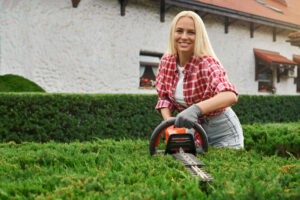Useful Tips For Lawn Care
Mowing The Lawn In Spring
You need to mow the lawn when the grass grows to 8-10 cm. You should leave about 6-7 centimeters. It is possible that by the time of the first mowing, the lawn will not have grown over the entire area. There’s nothing wrong with that: you can mow it down next time. Don’t forget to remove the grass clippings from the lawn; they should not be left behind.
The grass is almost always shorter where it has been cut with a trimmer than where a lawnmower has been used. This is because you cannot adjust the trimmer to a specific height. Therefore, when trimming, you must be aware of the height to avoid damaging the grass by cutting it too much. In some cases, in difficult areas, it may be easier to first trim around obstacles and then use a leaf blower to blow the edge-cutting debris into the grass area and only then move the mower over.
 Scarification (Combing)
Scarification (Combing)
During the scarification process, the lawn is cleared of last year’s grass and leaves. It is more correct to comb the lawn after treating the tree crowns – this way you will not have to perform this operation twice. If scarification is not carried out, pests may appear on the lawn, and mould may develop. For scarification, use a soft rake combing the lawn as carefully as possible. It would help if you were careful not to accidentally pull-out fresh sprouts.
Top Dressing
The application of mineral fertilizers is the most important step in lawn care after winter. Here, too, it is important to take your time. Fertilizers should be applied only when the lawn turns green. To fertilize, you can use fertilizer for fertilizing the lawn (specifically, a special lawn fertilizer), the main thing is to follow the recommendations on application rates. There is no need to overfeed the lawn.
Aeration
The next lawn care procedure in spring is aeration. It opens air access to the roots and removes excess moisture. Aeration is carried out with a four-pronged fork, piercing the turf to a depth of approximately 5-7 centimetres. Such movements need to be done in increments of 15-20 centimetres. Air will be able to penetrate the thickness of the lawn, and water will go lower. In addition, this way, the soil warms up faster. There is also a special tool for this procedure – an aerator. However, the simplest aerator will not be able to apply the necessary effort, and a professional tool is quite expensive and is used by professional teams. Therefore, using a fork for aeration is a win-win option. There are also special soles with spikes that fit on top of your shoes – you can use them.
Overseeding The Lawn
Most often, the lawn quickly recovers in the spring and does not suffer from weather changes. But in some areas (usually on hummocks or depressions), the lawn may weaken. This is especially true for old areas where there is soil subsidence. Bald spots appear in such places. For overseeding, use seeds of the same type of grass as the rest of the lawn. This way, the repaired areas will not stand out, and the lawn will look like a single whole. The soil is loosened, after which seeds, previously mixed with fertile soil, are added to it. After this, the sown area should be watered abundantly.